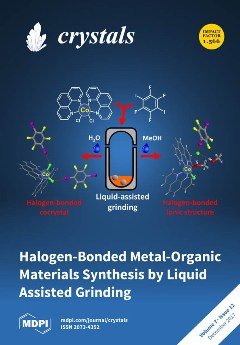Febuxostat (FB) is a poorly water-soluble drug that belongs to BCS class II. The drug is employed for the treatment of inflammatory disease arthritis urica (gout), and the free base, FB form-A, is most preferred for drug formulation. In order to achieve a
[...] Read more.
Febuxostat (FB) is a poorly water-soluble drug that belongs to BCS class II. The drug is employed for the treatment of inflammatory disease arthritis urica (gout), and the free base, FB form-A, is most preferred for drug formulation. In order to achieve a goal of improving the water solubility of FB form-A, this study was carried out using the cocrystallization technique called the liquid-assisted grinding method to produce FB cocrystals. Here, five amino acids containing amine (NH), oxygen (O), and hydroxyl (OH) functional groups, and possessing difference of pKa less than 3 with FB, were selected as coformers. Then, solvents including methanol, ethanol, isopropyl alcohol, n-hexane, dichloromethane, and acetone were used for the cocrystal screening. As a result, a cocrystal was obtained when acetone and
l-pyroglutamic acid (PG) of 0.5 eq. were employed as solvent and coformer, respectively. The ratio of 2:1, which is the ratio of FB to PG within FB-PG cocrystal, was predicted by means of solid-state CP/MAS
13C-NMR, solution-state NMR (
1H,
13C, and 2D) and FT-IR. Moreover, Powder X-ray Diffraction (PXRD), Differential Scanning Calorimetry (DSC), and Thermogravimetric Analysis (TGA) were used to investigate the characteristics of FB-PG cocrystal. In addition, comparative solubility tests between FB-PG cocrystal and FB form-A were conducted in deionized water and under simulated gastrointestinal pH (1.2, 4, and 6.8) conditions. The result revealed that FB-PG cocrystal has a solubility of four-fold higher than FB form-A in deionized water and two-fold and five-fold greater than FB form-A at simulated gastrointestinal pH 1.2 and pH 4, respectively. Besides, solubilities of FB-PG cocrystal and FB form-A at pH 6.8 were similar to the results measured in deionized water. Therefore, it is postulated that FB-PG cocrystal has a potential overcoming the limitations related to the low aqueous solubility of FB form-A. Accordingly, FB-PG cocrystal is suggested as an alternative active pharmaceutical ingredient of the currently used FB form-A.
Full article





